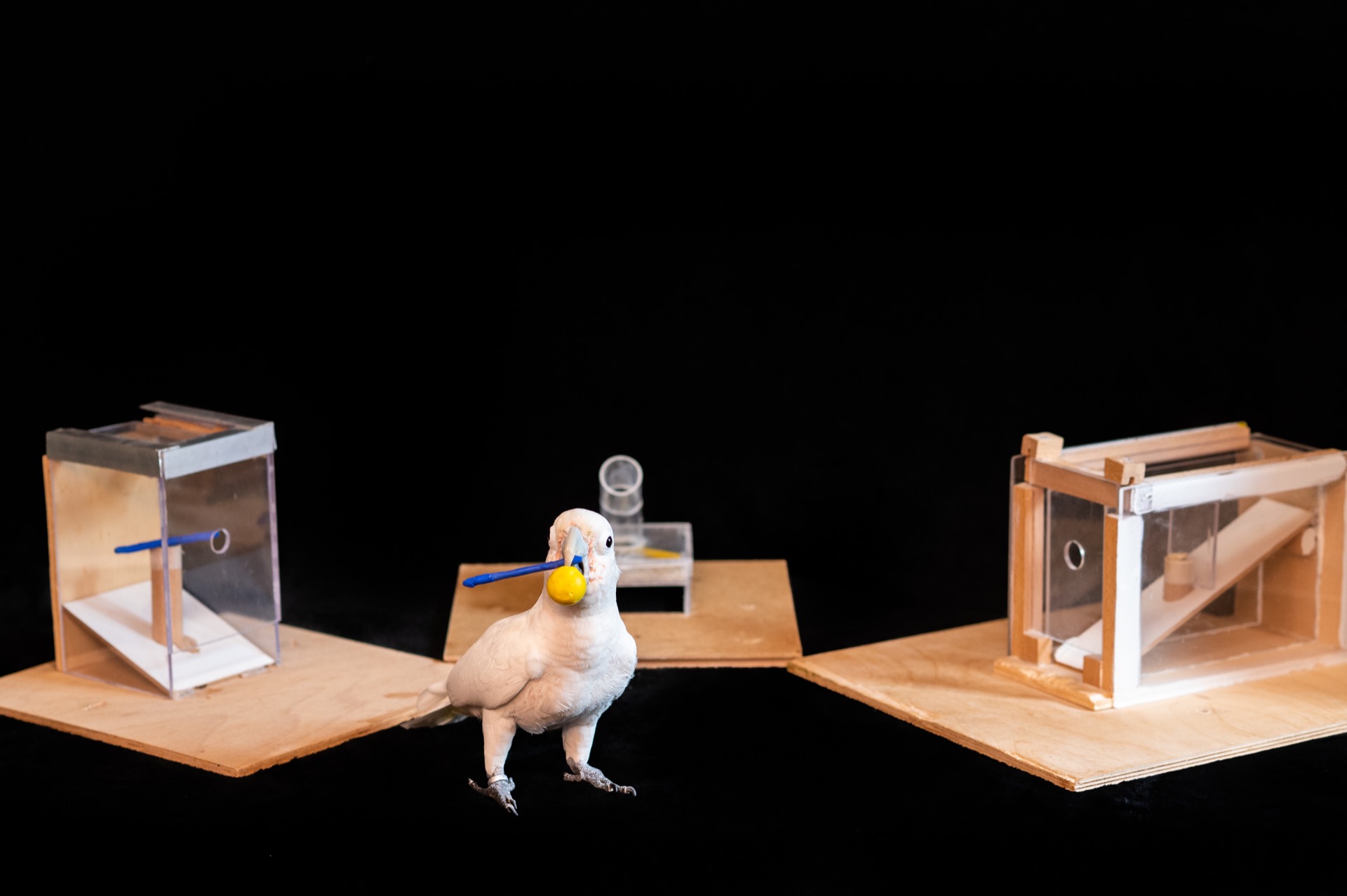
©Goffin Lab
Imagine that in order to escape the escape room, a robot has to solve a puzzle that consists of multiple rigid bodies and joints that can lock each other — a so-called lockbox. This is a type of sequential kinematic problem that some birds such as cockatoos can learn to solve, but as astonishing as this feat is, behavioral biology still cannot explain which characteristics empower the birds to exhibit this intelligent problem-solving behavior. In this project, behavioral biologists and roboticists get together to understand and explain this behavior in novel ways. We aim to identify prior knowledge and capabilities that the birds recruit for solving this task. To this end, we develop methodology to use robots as tools to understand animal behavior. We believe that robots are important ingredients to unveiling the mechanisms that enable cockatoos to solve lockboxes. This way, we will reveal the principles underlying kinematic problem-solving in general, such as representations or sensorimotor skills that biological and artificial systems require to solve such complex kinematic problems. We will not only better understand the biological behavior, but also improve our robotic systems. By identifying the building blocks that enable birds to solve this problem, we can either directly include these building blocks into the robotic system, or we can extract insights that will further guide robotics research. Where necessary, we will additionally develop robotic interactive perception skills along the way, thus contributing to the robotics community.
Project Results
The team originally set out to use robots as models for the adaptive, intelligent kinematic problem solving behavior of Goffin’s cockatoos. However, they soon realized that our contribution needs to go beyond “simply” using robots as models in this way, and that they actually need to dedicate significant effort to develop the research methodology itself. They developed and analyzed an approach to identify learning processes given candidate hypotheses. In this study they understood that a common problem in reinforcement learning, in the context of computer science, may also pose a significant problem in analytical studies of learning. To keep it brief, even if they manage to narrow down a list of candidate models, which include the correct model, a naive comparison to experimental data won’t suffice to identify the model. Another challenge that the team identified and started to address is the many-to-one problem. As many competing models could potentially explain our experimental data, a single mechanical model would not be a unique and sufficient explanation of the behavior we see. Rather, they need to make statements about larger sets of mechanical models in relation to the data. This is why they suggest a constraint-based approach where we incrementally gather constraints that may help them narrow down the set of valid models. Some of our research leaned more towards the synthetic side. Inspired by how Goffin’s cockatoos behavior is robust against unknown and changing dynamics as they manipulate lockboxes, they investigated how we can make robotic behavior robust against unforeseen disturbances and sudden changes in the state of the world. They developed a way to structure behavior such that it can quickly change between discrete behavioral modes and also showed that assumptions about the temporal order of such behaviors is not always necessary and that such assumptions may even be detrimental.
Related Publications +
2756394
proj004
1
apa
50
creator
desc
year
20159
https://www.scienceofintelligence.de/wp-content/plugins/zotpress/
%7B%22status%22%3A%22success%22%2C%22updateneeded%22%3Afalse%2C%22instance%22%3Afalse%2C%22meta%22%3A%7B%22request_last%22%3A0%2C%22request_next%22%3A0%2C%22used_cache%22%3Atrue%7D%2C%22data%22%3A%5B%7B%22key%22%3A%229ZNGL3SY%22%2C%22library%22%3A%7B%22id%22%3A2756394%7D%2C%22meta%22%3A%7B%22creatorSummary%22%3A%22Mengers%20et%20al.%22%2C%22parsedDate%22%3A%222023%22%2C%22numChildren%22%3A1%7D%2C%22bib%22%3A%22%26lt%3Bdiv%20class%3D%26quot%3Bcsl-bib-body%26quot%3B%20style%3D%26quot%3Bline-height%3A%202%3B%20padding-left%3A%201em%3B%20text-indent%3A-1em%3B%26quot%3B%26gt%3B%5Cn%20%20%26lt%3Bdiv%20class%3D%26quot%3Bcsl-entry%26quot%3B%26gt%3BMengers%2C%20V.%2C%20Battaje%2C%20A.%2C%20Baum%2C%20M.%2C%20%26amp%3B%20Brock%2C%20O.%20%282023%29.%20Combining%20Motion%20and%20Appearance%20for%20Robust%20Probabilistic%20Object%20Segmentation%20in%20Real%20Time.%20%26lt%3Bi%26gt%3BICRA%202023%26lt%3B%5C%2Fi%26gt%3B.%20%26lt%3Ba%20class%3D%26%23039%3Bzp-DOIURL%26%23039%3B%20href%3D%26%23039%3Bhttps%3A%5C%2F%5C%2Fdoi.org%5C%2F10.1109%5C%2FICRA48891.2023.10160908%26%23039%3B%26gt%3Bhttps%3A%5C%2F%5C%2Fdoi.org%5C%2F10.1109%5C%2FICRA48891.2023.10160908%26lt%3B%5C%2Fa%26gt%3B%26lt%3B%5C%2Fdiv%26gt%3B%5Cn%26lt%3B%5C%2Fdiv%26gt%3B%22%2C%22data%22%3A%7B%22itemType%22%3A%22conferencePaper%22%2C%22title%22%3A%22Combining%20Motion%20and%20Appearance%20for%20Robust%20Probabilistic%20Object%20Segmentation%20in%20Real%20Time%22%2C%22creators%22%3A%5B%7B%22creatorType%22%3A%22author%22%2C%22firstName%22%3A%22Vito%22%2C%22lastName%22%3A%22Mengers%22%7D%2C%7B%22creatorType%22%3A%22author%22%2C%22firstName%22%3A%22Aravind%22%2C%22lastName%22%3A%22Battaje%22%7D%2C%7B%22creatorType%22%3A%22author%22%2C%22firstName%22%3A%22Manuel%22%2C%22lastName%22%3A%22Baum%22%7D%2C%7B%22creatorType%22%3A%22author%22%2C%22firstName%22%3A%22Oliver%22%2C%22lastName%22%3A%22Brock%22%7D%5D%2C%22abstractNote%22%3A%22%22%2C%22date%22%3A%222023%22%2C%22proceedingsTitle%22%3A%22ICRA%202023%22%2C%22conferenceName%22%3A%22%22%2C%22language%22%3A%22%22%2C%22DOI%22%3A%2210.1109%5C%2FICRA48891.2023.10160908%22%2C%22ISBN%22%3A%22%22%2C%22url%22%3A%22%22%2C%22collections%22%3A%5B%5D%2C%22dateModified%22%3A%222025-09-26T13%3A16%3A16Z%22%7D%7D%2C%7B%22key%22%3A%22S2HRNVKL%22%2C%22library%22%3A%7B%22id%22%3A2756394%7D%2C%22meta%22%3A%7B%22creatorSummary%22%3A%22Baum%20et%20al.%22%2C%22parsedDate%22%3A%222023%22%2C%22numChildren%22%3A1%7D%2C%22bib%22%3A%22%26lt%3Bdiv%20class%3D%26quot%3Bcsl-bib-body%26quot%3B%20style%3D%26quot%3Bline-height%3A%202%3B%20padding-left%3A%201em%3B%20text-indent%3A-1em%3B%26quot%3B%26gt%3B%5Cn%20%20%26lt%3Bdiv%20class%3D%26quot%3Bcsl-entry%26quot%3B%26gt%3BBaum%2C%20M.%2C%20Froessl%2C%20A.%2C%20Battaje%2C%20A.%2C%20%26amp%3B%20Brock%2C%20O.%20%282023%29.%20Estimating%20the%20Motion%20of%20Drawers%20From%20Sound.%20%26lt%3Bi%26gt%3BICRA%202023%26lt%3B%5C%2Fi%26gt%3B.%20%26lt%3Ba%20class%3D%26%23039%3Bzp-DOIURL%26%23039%3B%20href%3D%26%23039%3Bhttps%3A%5C%2F%5C%2Fdoi.org%5C%2F10.1109%5C%2FICRA48891.2023.10161399%26%23039%3B%26gt%3Bhttps%3A%5C%2F%5C%2Fdoi.org%5C%2F10.1109%5C%2FICRA48891.2023.10161399%26lt%3B%5C%2Fa%26gt%3B%26lt%3B%5C%2Fdiv%26gt%3B%5Cn%26lt%3B%5C%2Fdiv%26gt%3B%22%2C%22data%22%3A%7B%22itemType%22%3A%22conferencePaper%22%2C%22title%22%3A%22Estimating%20the%20Motion%20of%20Drawers%20From%20Sound%22%2C%22creators%22%3A%5B%7B%22creatorType%22%3A%22author%22%2C%22firstName%22%3A%22Manuel%22%2C%22lastName%22%3A%22Baum%22%7D%2C%7B%22creatorType%22%3A%22author%22%2C%22firstName%22%3A%22Amelie%22%2C%22lastName%22%3A%22Froessl%22%7D%2C%7B%22creatorType%22%3A%22author%22%2C%22firstName%22%3A%22Aravind%22%2C%22lastName%22%3A%22Battaje%22%7D%2C%7B%22creatorType%22%3A%22author%22%2C%22firstName%22%3A%22Oliver%22%2C%22lastName%22%3A%22Brock%22%7D%5D%2C%22abstractNote%22%3A%22%22%2C%22date%22%3A%222023%22%2C%22proceedingsTitle%22%3A%22ICRA%202023%22%2C%22conferenceName%22%3A%22%22%2C%22language%22%3A%22%22%2C%22DOI%22%3A%2210.1109%5C%2FICRA48891.2023.10161399%22%2C%22ISBN%22%3A%22%22%2C%22url%22%3A%22%22%2C%22collections%22%3A%5B%5D%2C%22dateModified%22%3A%222025-09-26T13%3A16%3A18Z%22%7D%7D%2C%7B%22key%22%3A%22KME33XVM%22%2C%22library%22%3A%7B%22id%22%3A2756394%7D%2C%22meta%22%3A%7B%22creatorSummary%22%3A%22Baum%20and%20Brock%22%2C%22parsedDate%22%3A%222022%22%2C%22numChildren%22%3A1%7D%2C%22bib%22%3A%22%26lt%3Bdiv%20class%3D%26quot%3Bcsl-bib-body%26quot%3B%20style%3D%26quot%3Bline-height%3A%202%3B%20padding-left%3A%201em%3B%20text-indent%3A-1em%3B%26quot%3B%26gt%3B%5Cn%20%20%26lt%3Bdiv%20class%3D%26quot%3Bcsl-entry%26quot%3B%26gt%3BBaum%2C%20M.%2C%20%26amp%3B%20Brock%2C%20O.%20%282022%29.%20%26%23x201C%3BThe%20World%20Is%20Its%20Own%20Best%20Model%26%23x201D%3B%3A%20Robust%20Real-World%20Manipulation%20Through%20Online%20Behavior%20Selection.%20%26lt%3Bi%26gt%3BICRA%202022%26lt%3B%5C%2Fi%26gt%3B.%20%26lt%3Ba%20class%3D%26%23039%3Bzp-DOIURL%26%23039%3B%20href%3D%26%23039%3Bhttps%3A%5C%2F%5C%2Fdoi.org%5C%2F10.1109%5C%2FICRA46639.2022.9811845%26%23039%3B%26gt%3Bhttps%3A%5C%2F%5C%2Fdoi.org%5C%2F10.1109%5C%2FICRA46639.2022.9811845%26lt%3B%5C%2Fa%26gt%3B%26lt%3B%5C%2Fdiv%26gt%3B%5Cn%26lt%3B%5C%2Fdiv%26gt%3B%22%2C%22data%22%3A%7B%22itemType%22%3A%22conferencePaper%22%2C%22title%22%3A%22%5C%22The%20World%20Is%20Its%20Own%20Best%20Model%5C%22%3A%20Robust%20Real-World%20Manipulation%20Through%20Online%20Behavior%20Selection%22%2C%22creators%22%3A%5B%7B%22creatorType%22%3A%22author%22%2C%22firstName%22%3A%22Manuel%22%2C%22lastName%22%3A%22Baum%22%7D%2C%7B%22creatorType%22%3A%22author%22%2C%22firstName%22%3A%22Oliver%22%2C%22lastName%22%3A%22Brock%22%7D%5D%2C%22abstractNote%22%3A%22%22%2C%22date%22%3A%222022%22%2C%22proceedingsTitle%22%3A%22ICRA%202022%22%2C%22conferenceName%22%3A%22%22%2C%22language%22%3A%22%22%2C%22DOI%22%3A%2210.1109%5C%2FICRA46639.2022.9811845%22%2C%22ISBN%22%3A%22%22%2C%22url%22%3A%22https%3A%5C%2F%5C%2Fieeexplore.ieee.org%5C%2Fdocument%5C%2F9811845%22%2C%22collections%22%3A%5B%5D%2C%22dateModified%22%3A%222025-09-26T13%3A16%3A18Z%22%7D%7D%2C%7B%22key%22%3A%224QS7RBSU%22%2C%22library%22%3A%7B%22id%22%3A2756394%7D%2C%22meta%22%3A%7B%22creatorSummary%22%3A%22Baum%20and%20Brock%22%2C%22parsedDate%22%3A%222021%22%2C%22numChildren%22%3A1%7D%2C%22bib%22%3A%22%26lt%3Bdiv%20class%3D%26quot%3Bcsl-bib-body%26quot%3B%20style%3D%26quot%3Bline-height%3A%202%3B%20padding-left%3A%201em%3B%20text-indent%3A-1em%3B%26quot%3B%26gt%3B%5Cn%20%20%26lt%3Bdiv%20class%3D%26quot%3Bcsl-entry%26quot%3B%26gt%3BBaum%2C%20M.%2C%20%26amp%3B%20Brock%2C%20O.%20%282021%29.%20Achieving%20Robustness%20in%20a%20Drawer%20Manipulation%20Task%20by%20using%20High-level%20Feedback%20instead%20of%20Planning.%20%26lt%3Bi%26gt%3BDGR%20Days%26lt%3B%5C%2Fi%26gt%3B.%20%26lt%3Ba%20class%3D%26%23039%3Bzp-ItemURL%26%23039%3B%20href%3D%26%23039%3Bhttps%3A%5C%2F%5C%2Fwww.static.tu.berlin%5C%2Ffileadmin%5C%2Fwww%5C%2F10002220%5C%2FPublications%5C%2Fbaum21DGR.pdf%26%23039%3B%26gt%3Bhttps%3A%5C%2F%5C%2Fwww.static.tu.berlin%5C%2Ffileadmin%5C%2Fwww%5C%2F10002220%5C%2FPublications%5C%2Fbaum21DGR.pdf%26lt%3B%5C%2Fa%26gt%3B%26lt%3B%5C%2Fdiv%26gt%3B%5Cn%26lt%3B%5C%2Fdiv%26gt%3B%22%2C%22data%22%3A%7B%22itemType%22%3A%22conferencePaper%22%2C%22title%22%3A%22Achieving%20Robustness%20in%20a%20Drawer%20Manipulation%20Task%20by%20using%20High-level%20Feedback%20instead%20of%20Planning%22%2C%22creators%22%3A%5B%7B%22creatorType%22%3A%22author%22%2C%22firstName%22%3A%22Manuel%22%2C%22lastName%22%3A%22Baum%22%7D%2C%7B%22creatorType%22%3A%22author%22%2C%22firstName%22%3A%22Oliver%22%2C%22lastName%22%3A%22Brock%22%7D%5D%2C%22abstractNote%22%3A%22%22%2C%22date%22%3A%222021%22%2C%22proceedingsTitle%22%3A%22DGR%20Days%22%2C%22conferenceName%22%3A%22%22%2C%22language%22%3A%22%22%2C%22DOI%22%3A%22%22%2C%22ISBN%22%3A%22%22%2C%22url%22%3A%22https%3A%5C%2F%5C%2Fwww.static.tu.berlin%5C%2Ffileadmin%5C%2Fwww%5C%2F10002220%5C%2FPublications%5C%2Fbaum21DGR.pdf%22%2C%22collections%22%3A%5B%5D%2C%22dateModified%22%3A%222025-09-26T13%3A16%3A12Z%22%7D%7D%5D%7D
Mengers, V., Battaje, A., Baum, M., & Brock, O. (2023). Combining Motion and Appearance for Robust Probabilistic Object Segmentation in Real Time.
ICRA 2023.
https://doi.org/10.1109/ICRA48891.2023.10160908
Baum, M., Froessl, A., Battaje, A., & Brock, O. (2023). Estimating the Motion of Drawers From Sound.
ICRA 2023.
https://doi.org/10.1109/ICRA48891.2023.10161399
Baum, M., & Brock, O. (2022). “The World Is Its Own Best Model”: Robust Real-World Manipulation Through Online Behavior Selection.
ICRA 2022.
https://doi.org/10.1109/ICRA46639.2022.9811845
Baum, M., & Brock, O. (2021). Achieving Robustness in a Drawer Manipulation Task by using High-level Feedback instead of Planning.
DGR Days.
https://www.static.tu.berlin/fileadmin/www/10002220/Publications/baum21DGR.pdf





